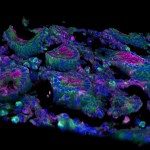Link to Pubmed [PMID] – 22529893
Link to DOI – 10.1371/journal.pone.0033502
PLoS One 2012 ; 7(4): e33502
The genome of human immunodeficiency virus (HIV) has an average nucleotide composition strongly biased as compared to the human genome. The consequence of such nucleotide composition on HIV pathogenicity has not been investigated yet. To address this question, we analyzed the role of nucleotide bias of HIV-derived nucleic acids in stimulating type-I interferon response in vitro. We found that the biased nucleotide composition of HIV is detected in human cells as compared to humanized sequences, and triggers a strong innate immune response, suggesting the existence of cellular immune mechanisms able to discriminate RNA sequences according to their nucleotide composition or to detect specific secondary structures or linear motifs within biased RNA sequences. We then extended our analysis to the entire genome scale by testing more than 1300 HIV-1 complete genomes to look for an association between nucleotide composition of HIV-1 group M subtypes and their pathogenicity. We found that subtype D, which has an increased pathogenicity compared to the other subtypes, has the most divergent nucleotide composition relative to the human genome. These data support the hypothesis that the biased nucleotide composition of HIV-1 may be related to its pathogenicity.

